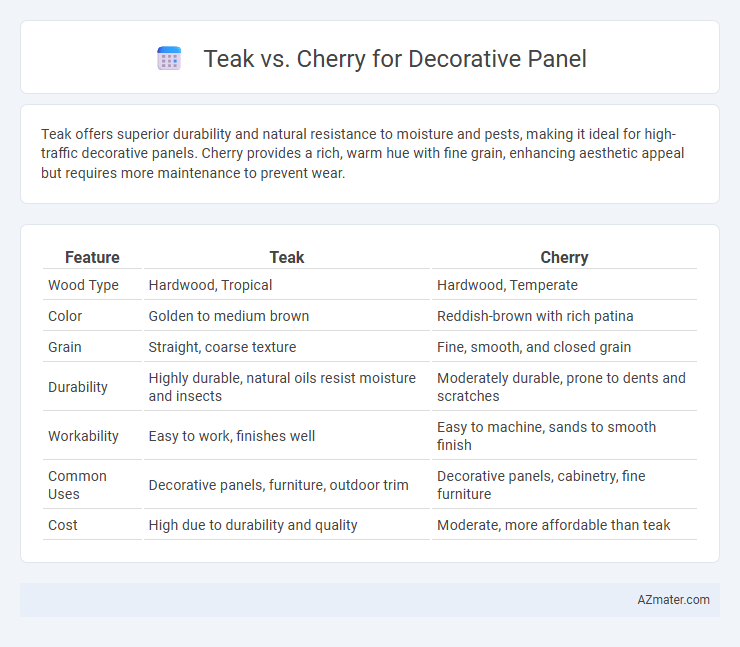Teak offers superior durability and natural resistance to moisture and pests, making it ideal for high-traffic decorative panels. Cherry provides a rich, warm hue with fine grain, enhancing aesthetic appeal but requires more maintenance to prevent wear.
Table of Comparison
| Feature | Teak | Cherry |
|---|---|---|
| Wood Type | Hardwood, Tropical | Hardwood, Temperate |
| Color | Golden to medium brown | Reddish-brown with rich patina |
| Grain | Straight, coarse texture | Fine, smooth, and closed grain |
| Durability | Highly durable, natural oils resist moisture and insects | Moderately durable, prone to dents and scratches |
| Workability | Easy to work, finishes well | Easy to machine, sands to smooth finish |
| Common Uses | Decorative panels, furniture, outdoor trim | Decorative panels, cabinetry, fine furniture |
| Cost | High due to durability and quality | Moderate, more affordable than teak |
Introduction to Teak and Cherry Wood
Teak wood, prized for its natural oils and dense grain, offers exceptional durability and resistance to moisture, making it ideal for decorative panels in high-humidity environments. Cherry wood, renowned for its rich reddish-brown color and smooth texture, ages beautifully with a deepening patina that enhances panel aesthetics over time. Both hardwoods provide unique visual appeal and strength, but teak's resilience contrasts with cherry's warmth and elegance, influencing their selection for interior design applications.
Visual Characteristics: Grain and Color
Teak features a straight, tight grain pattern with a rich golden-brown hue that deepens with age, providing a warm, luxurious appearance ideal for decorative panels. Cherry wood displays a fine, smooth grain with a reddish-brown color that darkens to a rich mahogany over time, offering a classic and elegant look. Both woods exhibit distinct aging processes that enhance their natural beauty, making them popular choices for high-end interior design applications.
Durability and Hardness Comparison
Teak wood is renowned for its exceptional durability, boasting high natural oil content that provides resistance to moisture, pests, and decay, making it ideal for decorative panels in humid environments. Cherry wood, while moderately hard with a Janka hardness rating of around 950, offers less resistance to wear compared to teak's rating of approximately 1,070, but is prized for its fine grain and smooth finish. For long-lasting decorative panels requiring robust hardness and superior durability, teak outperforms cherry, maintaining structural integrity and aesthetic appeal over time.
Workability and Ease of Finishing
Teak wood offers excellent workability with its moderate density and natural oils, which also contribute to a smooth finishing process but may require extra preparation to ensure proper paint or varnish adhesion. Cherry is highly regarded for its fine, straight grain and uniform texture, making it exceptionally easy to machine and finish, resulting in a rich, lustrous surface with minimal effort. Both woods provide distinct advantages; teak's natural oils enhance durability, while cherry's consistent grain facilitates superior staining and polishing for decorative panels.
Moisture Resistance and Stability
Teak offers superior moisture resistance due to its natural oils, making it highly stable in humid environments and less prone to warping or swelling compared to cherry wood. Cherry, while prized for its rich color and fine grain, is more susceptible to moisture absorption, which can cause dimensional changes and reduce long-term stability. For decorative panels requiring durability in variable humidity, teak is the preferred choice for maintaining structural integrity and aesthetic appeal.
Suitability for Decorative Panel Applications
Teak offers exceptional durability and moisture resistance, making it ideal for decorative panels in high-humidity environments such as bathrooms and kitchens. Cherry wood provides a smooth grain and rich reddish-brown color that enhances indoor panel aesthetics but may require sealing to protect against moisture. Both woods suit decorative panels, with teak favored for strength and longevity, while cherry excels in elegant, refined interior designs.
Cost and Availability in the Market
Teak typically commands a higher price than cherry due to its durability and resistance to moisture, making it a premium choice for decorative panels. Cherry wood offers more affordable pricing and wider availability, especially in North America, due to faster growth rates and abundant supply. Both woods are popular, but teak's limited availability and import costs often elevate its market price compared to the more readily accessible cherry.
Environmental Impact and Sustainability
Teak, known for its natural oils and durability, offers long-lasting decorative panels but often comes from slow-growing plantations or tropical forests, raising concerns about deforestation and habitat loss. Cherry wood, sourced primarily from North American forests, regenerates more quickly and is commonly harvested from sustainably managed sources, reducing its environmental footprint. Choosing panels certified by organizations like FSC or PEFC ensures the materials are responsibly sourced, promoting sustainability in both teak and cherry products.
Maintenance and Longevity
Teak offers superior durability and requires minimal maintenance due to its natural oils that resist moisture, pests, and decay, making it ideal for long-lasting decorative panels. Cherry wood, while aesthetically pleasing with its rich color and smooth grain, demands more frequent care, including polishing and protection from moisture to prevent warping or fading. Over time, teak's resilience ensures greater longevity, whereas cherry panels may need refinishing or replacement sooner in high-humidity environments.
Final Recommendation: Teak or Cherry for Decorative Panels
Teak offers exceptional durability, natural weather resistance, and rich golden-brown hues, making it ideal for high-traffic or moisture-prone decorative panels. Cherry wood provides a smooth grain, warm reddish tones, and excellent workability, perfect for elegant indoor applications with a refined finish. Choose Teak for long-lasting outdoor or humid environments, while Cherry suits interior panels where aesthetic warmth and intricate detailing are prioritized.

Infographic: Teak vs Cherry for Decorative Panel
 azmater.com
azmater.com